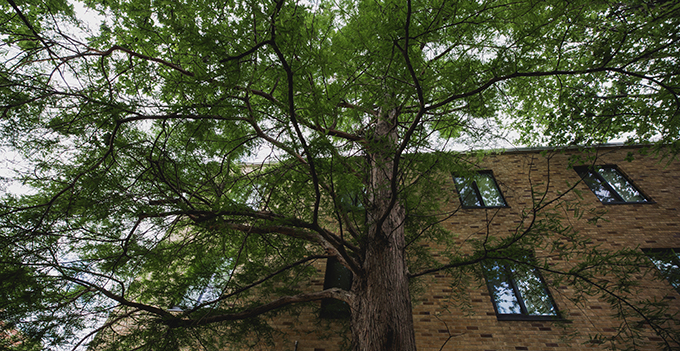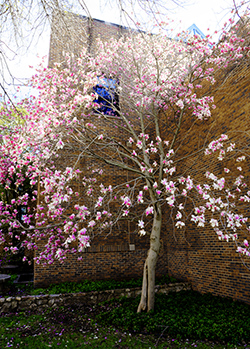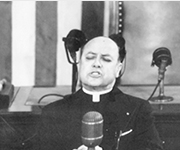Campus Branches
Northwestern’s carefully tended trees include species more commonly found in southern swamps, European forests and Chinese gardens
BY TAMARA FYNAARDT
PHOTOS BY JENNI (SYBESMA ’09) OCHSNER AND DOUG BURG

Students study under them, sway in hammocks hanging from them, and toss Frisbees at them as they stand in for “holes” in disc golf. They throw shade, old-style, for the students who stroll under them tweeting comic insults that “throw shade” Gen Z-style. They’re the living landmarks of campus: Northwestern’s trees.

Nearly everyone who spends time on campus enjoys their charms— from the gauzy spring blooms of the crabapples near Christ Chapel to the water-like rustling of the leaves on the towering cottonwood near the soccer fields—but few know Northwestern’s trees as intimately as biology professor emeritus Glen Hegstad. Hegstad taught at Northwestern for 25 years and charts his time on campus through memories of trees that have come and gone.
“They all went,” he says, running his fingers over a photograph of American elms standing fortress-like along the south side of Van Peursem Hall when he arrived in 1967. He looks as if he has lost a friend. Hegstad sounds similarly wistful remembering the beginnings of numerous Colorado blue spruces still growing on campus. A note in his binder of NWC history recalls “100 little seedlings ([the] size of one’s small finger) … planted in #10 tin cans from the college cafeteria … [and] nurtured in the backyard of Granberg Hall.”
Hegstad is responsible for planting some of the most unusual trees on campus. When a new science wing was added to Van Peursem Hall in 1967, creating a U-shaped alcove on the north side, then-president Dr. Lars Granberg, an avid naturalist, commissioned the Alumni Garden.
Dorothy Van Eck, wife of former biology professor Edward Van Eck, designed the garden, and Hegstad selected the vegetation, much of which is still growing there today. The sheltered habitat includes three magnolia trees, a juneberry tree, and the only green beech tree in Orange City. Most unusual is the ginkgo tree, a species native to China.
For years, NWC’s ginkgo tree was the only one in Orange City. Recently, though, a sapling was planted across town by Hegstad’s daughter Christine Dykstra ’79 to replace a doomed ash tree. “I told her, keep it wet, keep it wet,” Hegstad says. He offers frequent advice for how the new ginkgo should be cared for, sounding a little like a botanical grandpa. 
 Looking for the perfect present for that special someone? We’ve got a selection of products made by Northwestern alumni.
Looking for the perfect present for that special someone? We’ve got a selection of products made by Northwestern alumni. Former biology professor Glen Hegstad explains the history behind Northwestern’s most unusual species of trees.
Former biology professor Glen Hegstad explains the history behind Northwestern’s most unusual species of trees. Two years ago, a motorcycle accident nearly killed Ardie Keune. Now mostly recovered, he’s grateful for the support of so many, including his Raider coaches and teammates.
Two years ago, a motorcycle accident nearly killed Ardie Keune. Now mostly recovered, he’s grateful for the support of so many, including his Raider coaches and teammates. After graduating from Northwestern Classical Academy, Bernard Braskamp capped a long career in the ministry by serving as chaplain to members of the U.S. House of Representatives.
After graduating from Northwestern Classical Academy, Bernard Braskamp capped a long career in the ministry by serving as chaplain to members of the U.S. House of Representatives.
Classic Comments
All comments are moderated and need approval from the moderator before they are posted. Comments that include profanity, or personal attacks, or antisocial behavior such as "spamming" or other inappropriate comments or material will be removed from the site. We will take steps to block users who violate any of our terms of use. You are fully responsible for the content that you post. Comments posted do not reflect the views or values of Northwestern College.